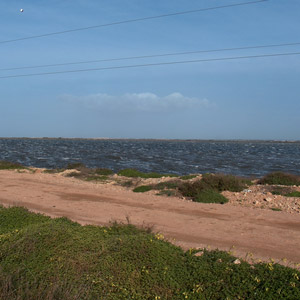Magazine | Voyages
Où observer les oiseaux en Sardaigne ?

Vue de la lagune de Santa Gilla, l’une des parties de l’étang de Cagliari, l’une des plus grandes zones humides de Sardaigne.Photographie : Giancarlo Dessì / Wikipedia
Introduction
« Je ne vais pas en Italie, je vais en Sardaigne ! » : voici ce que disait en l’an 700 le scientifique Francesco Cetti en faisant allusion au caractère unique de la nature de cette île. Encore aujourd’hui, la Sardaigne abrite des animaux et des végétaux que l’on ne retrouve pas dans le reste de l’Italie.
La richesse ornithologique y est remarquable, avec 360 espèces, soit plus de 7O% de l’avifaune italienne. En particulier, 18 sous-espèces endémiques y sont présentes, dont celle du Pic épeiche (Dendrocops major harterti), de la Mésange charbonnière (Parus major ecki), du Geai des chênes (Garrulus glandarius ichnusae), du Grand Corbeau (Corvus corax sardus) et du Pinson des arbres (Fringilla coelebs sarda) que l’on ne rencontre que sur l’île; pratiquement toutes les autres ont une distribution limitée à la Sardaigne et à la Corse.
En outre, certaines espèces sont rares, localisées ou absentes dans le reste de l’Italie comme la Talève sultane (Porphyrio porphyrio), le Goéland d’Audouin (Larus audouinii), la Perdrix gambra (Alectoris barbara), l’Outarde canepetière (Tetrax tetrax), la Fauvette sarde (Sylvia sarda) et le Venturon corse (Carduelis corsicana). L’observateur pourra également observer de beaux effectifs d’oiseaux moins rares comme le Cormoran huppé (Phalacrocorax aristotelis), le Flamant rose (Phoenicopterus roseus) ou l’Etourneau unicolore (Sturnus unicolor).
En migration, un grand nombre de passereaux et de limicoles stationnent ou passent.
En résumé, la Sardaigne offre des spectacles qui ont peu d’équivalents dans autres parties de l’Italie.
Marcello Grussu, du Gruppo Ornitologico Sardo, partage avec nous sa connaissance des oiseaux de l’île.
Abstract
Sardinia, the second largest island in the Mediterranean sea, is the home of unique birds and vegetals. More than 360 specie of birds have been recorded, i.e. more than 7O% of the Italian avifauna. In particular, 18 endemic subspecies are present, of which the one of the Middle Spotted Woodpecker (Dendrocopos major harterti), of the Great Tit (Parus major ecki), of the Jay (Garrulus glandarius ichnusae), of the Raven (Corvus corax sardus) and of the Common Finch (Fringilla coelebs sarda) can only be watched here; the others have a distribution limited to Sardinia and Corsica.
Moreover, some species are rare, localised or absent in the others regions of Italy, like the Purple Swamphen (Porphyrio porphyrio), the Audouin’s Gull (Larus audouinii), the Barbary Partridge (Alectoris barbara), the Little Bustard (Tetrax tetrax), the Mamora’s Warbler (Sylvia sarda) and the Corsican Citril Finch (Carduelis corsicana).
The birdwatcher will also discover numerous Shags (Phalacrocorax aristotelis), Greater Flamingoes (Phoenicopterus roseus) and Unicolor Starlings (Sturnus unicolor).
During the migrations, a great number of Passerines and waders stay or migrate in the island. Briefly speaking, Sardinia offers birding rares in the other regions of Italy.
In this article, Marcello Grussu, a member of the Gruppo Ornitologico Sardo, presents us the best spots and periods to watch the birding Sardinian specialities.
The G.O.S. organizes daily mini-birding tours at the end of Spring departing from Cagliari, and Marcello Grussu organizes complete tours for individuals or groups.
Poursuivez la lecture de cet article, en vous abonnant dès maintenant !
Découvrez les Archives d’Ornithomedia.com
Pour seulement 10,00 €TTC/an (ou 6,00 € les 6 mois)
Profitez de plusieurs centaines d’articles en accès illimité et sans aucun engagement.
Compléments
Auteur
Pour toute question, ou pour participer à une sortie ornithologique pendant votre séjour en Sardaigne, n’hésitez-pas à contacter Marcello Grussu (porphyrio@tiscali.it)
À lire aussi sur Ornithomedia.com
À lire sur le web
Le Gruppo Ornitologico Sardo : http://gruppoornitologicosardo.blogspot.fr/
Ouvrages recommandés
- Carte LOCAL Sardaigne de Collectif Michelin
- Where to Watch Birds in Italy de Lega Italiana Protezione Uccelli
Sources
- Brichetti P., De Franceschi P. & Baccetti N. (eds.) 1992. Fauna d’Italia XXIX. Aves I. Calderini.
- Grussu M. 1995, 1996. Distribuzione e popolazione degli uccelli nidificanti in Sardegna (Italia) al 1995. Gli Uccelli d’Italia 20: 77-85; 21: 5-16
- Grussu M. 1999. Status and breeding ecology of the Purple Swamphen in Italy. British Birds 92 (4): 183-192
- Grussu M. 2001a. Checklist of the birds of Sardinia. Updated to December 2001. Aves Ichnusae 4: 2-55
- Grussu M. (red.) 2001b. Recenti avvistamenti. Periodo: aprile 1999 – marzo 2000. Aves Ichnusae 4: 73-81
- Grussu M. & Diana F. 1998. Classificazione delle nuove I.B.A. (Important Bird Areas) in Sardegna. Aves Ichnusae 1: 3-20
- Grussu M. & Tinarelli R. 2000. La Pernice di mare in Italia. QB – Quaderni di Birdwatching 2 (4), ottobre: www.ebnitalia.it
- Grussu M. & Ruzzante G. & Secci A. 2000. Il Mignattaio, Plegadis falcinellus, nidifica ancora in Sardegna. Rivista italiana di Ornitologia 70: 87-89




Aucun commentaire sur ce sujet
Participer à la discussion !